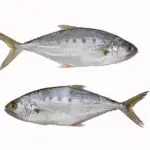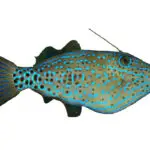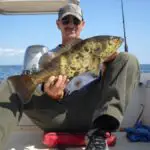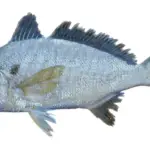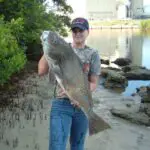Jack crevalle are a large and powerful predatory fish with carnivorous feeding habits.
Jack Crevalle will aggressively attack and eat anything that they can, but typically prefer smaller schooling fish, such as pinfish, mullet, anchovies, atlantic bumper, croaker and mackerel as the bulk of their diet.
They are known to be opportunistic predators, and if the opportunity presents itself, they will also gladly enjoy other things like shrimp, crabs, and squid.
Table of Contents
- Jack Crevalle Diet and Eating Habits
- Do Jack Crevalle Feed at Night?
- Do Jack Crevalle Feed in Schools?
- What is a Jack Attack?
- What Fish Eat Crevalle?
- How Big Can Jack Crevalle Get?
- Related Posts
Jack Crevalle Diet and Eating Habits
Several studies have been done on the widely variable diet of the Jack Crevalle.
They’ve concluded that jacks are indiscriminate in their feeding habits and their diets vary based on age, location, size of fish, and their available prey.
Their diets typically consist of 60-75% of small baitfish, with the remainder made up of other small organisms and crustaceans.

Due to their diets and active feeding habits, these fish don’t rank high on the edibility scale and are known to have tough meat and a strong, pungent taste.
They are, however, super fun to target and catch as they are very aggressive and great fighters.
Do Jack Crevalle Feed at Night?
Jack crevalle are diurnal fish. Diurnal is the opposite of nocturnal, and means that they are mostly active during the day.
Because jack crevalle are diurnal, they do not feed as much at night and it can be extremely difficult to catch them during this time.
Many anglers have reported catching jack crevalle at night when fishing around areas that have artificial lights.
The best time to fish for jack crevalle is during the daylight hours, especially during the mornings when the fish are hungry from not feeding all night.
Do Jack Crevalle Feed in Schools?
Many species of fish prefer to live, travel, and feed in large schools. This helps to better protect themselves from predators, increase their odds of finding food, and even swim more efficiently.
Jack crevalle love to feed and travel in large schools. They will form in medium to large schools during most of their lives.
As they get older, they tend to move off by themselves and become much more solitary.
Schools can be made of as few as a couple of fish and can be as large as 50 individual fish or more.
The size of the school will depend on the age of the fish, environmental conditions, and available food sources.
You can often spot a large school of jack crevalle swimming under the surface by there V-shaped wakes and forked tails sticking out above the surface.
What is a Jack Attack?
Many anglers may be familiar with the term “Jack Attack”. This refers to the hard-hitting and aggressive nature of the jack crevalle and how hard they hit your bait or lure.
Anytime you get a large strike or hit on your bait or lure, you can consider it a ‘jack attack.’
While some are larger than others, getting a jack attack while fishing is a great adrenaline rush.
Most anglers consider jack attacks to only occur while topwater fishing, since its the most exciting and aggressive form of a strike.
When conditions are right and you use the best lures, topwater fishing for these jacks is action-packed and exhilarating.
People may debate on whether or not a jack crevalle is a trash fish or not…but NO ONE debates that these powerful fish can put up a fight!
What Fish Eat Crevalle?
Younger jack crevalle have many predators that they are vulnerable to, and some full-grown adults have some natural predators aside from humans.
Young jack crevalle are prey for any fish that are larger than them, as well as sea birds such as pelicans and seagulls.
Larger jacks will be prey for bigger fish such as marlin, sharks and barracuda.
Juvenile jack crevalle are especially vulnerable while near the surface, feeding on baitfish like glass minnows.
This is when surface hunting fish (like sailfish) can strike them while they are busy feeding on smaller fish and too small to escape.
Live jack crevalle are often used as bait for big fish such as sharks and goliath groupers. Most states do not have a size or bag limit, so anglers often keep them for bait.
Cut jack crevalle can be used as bait for an even wider range of species such as stingray, barracuda, and even other jack crevalles!
How Big Can Jack Crevalle Get?
Jack crevalle come in many different sizes depending on their age and availability of food.
Jack crevalle can grow to some impressive sizes when conditions are right and they get older.
The biggest jack crevalle have been recorded to be around 40 inches in length and up to 55 pounds. These sizes are not normal, however, and are extremely rare to find.
The current world was caught off of the coast of Africa and stands at 66 pounds.
Jack crevalle will generally get to their full size once they reach maturity. This happens at 5 to 6 years of age, but these fish can live up to 15 years or longer.
In this species, females are usually much larger than males.
You May Also Like: What Do Mullet Eat? You Might Be Surprised!

Growing up in Florida, I’ve been surrounded by saltwater my entire life…and I love sharing my passion with others.
To learn more about why I started Saltwater Mecca, visit the ABOUT page.
Thank you for reading this article. Browse around & have some fun!

